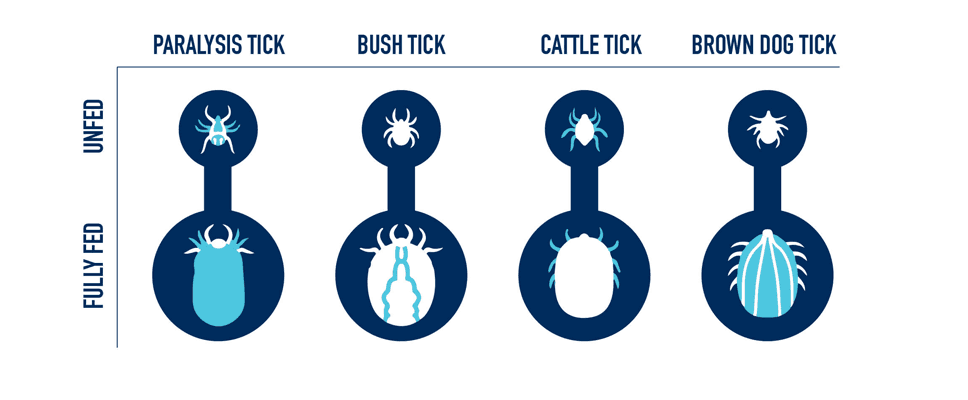
All ticks on dogs and cats present a level of threat to your pet's health and should always be taken seriously – even if your pet has never contracted one.
To keep your dog or cat tick free, it’s helpful to understand what ticks are, how they can be prevented - or in less fortunate cases detected and removed. We spoke to Dr Alison Kemp from our VET team, to talk us through all the major tick questions.
What Are The Types Of Ticks On Dogs And Cats?
When we refer to ticks, we are not just talking about one type of tick as there are many different species. Unlike fleas, which are insects, ticks are arachnids (like spiders). There are over 70 different species of ticks found in Australia. The four most common of these being the major cause for concern.
Common Tick Species

Paralysis Tick: Ixodes Holocyclus
This is the most important one to watch out for as it can cause the most damage to your pet, since it injects poison when it feeds. Living along the east coast of Australia, this tick is usually found in grassy fields or vegetation. It can be as small as a pinhead, or as large as a fingernail – depending on how much blood it has fed on. While the paralysis tick is mostly found on dogs, it can also be found on cats.
“The paralysis tick is the one we worry about most since when it bites, it injects a powerful neurotoxin into the body, which can be fatal to dogs and cats,” says Dr Alison.
Signs Of Tick Paralysis:
As the most dangerous tick for your dog or cat to encounter, it’s really important to be able to recognise the signs of illness or effects of a paralysis tick, well before it becomes critical. Although some of the early symptoms may seem like a variety of common illnesses or ailments, it could in fact be a paralysis tick which is to blame.
If you notice the earlier symptoms, it’s worth speaking to your vet as soon as you can to get the best medical advice.
- Coughing
- Vomiting
- Wobbliness
- Sitting down often
- Panting which progresses to collapse and paralysis, starting with the hind leg (critical)
You can also check your dog’s coat with a fine-tooth comb to see if a tick is attached, paying close attention to hidden areas such as deep inside your dog’s ear, between toes, or even around their bottom.
It's best to get your dog checked by a vet if you suspect your dog may have a tick.
Brown Dog Tick: Rhipicephalus Sanguineus
This tick is a reddish-brown colour, and is commonly found indoors and in kennels. Dogs are their most common host (hence the name) but they will latch onto cats too. They prefer warmer climates and will often complete their entire lifecycle indoors. Ensure a clean environment to prevent eggs hatching inside your home or in pet's bedding.
Although not as deadly as the paralysis tick, this tick can cause irritation to your pet’s body and can carry diseases, including canine-specific diseases - Canine Ehrlichiosis and Canine Babesia - which can cause bleeding disorders, systemic shock and fever.
Bush Tick: Haemaphysalis Longicornis
A bush tick is primarily found in the Northern Territory, Queensland and Western Australia, and in its early unfed stage it is very red in colour, but it changes to a greyer colour when fully fed. The most common effect this tick can have on your dog or cat is mostly skin irritation and localised infection on the wound area.
Cattle Tick: Rhipicephalus (Boophilus) Microplus
As the name suggests, a cattle tick is primarily found on cattle, but it can latch onto other animals, including a dog. Like the bush tick or brown dog tick, it carries diseases, in this case, blood-borne tick fever organisms, which can lead to Babesiosis and Anaplasmosis. Both of these diseases can be very severe and sometimes fatal, so early detection is crucial.
Did you know? Ticks are small to begin with, but as they feed, they grow and become fully engorged. Once they are fully engorged, they drop off.
How Do Ticks Affect Dogs And Cats? Do Ticks Hurt?
When it comes to detecting whether your dog or cat has a tick, there are many different signs and symptoms, which vary dependent on the type of tick. Usually, if your pet has a less dangerous tick (brown, bush, or cattle tick), they may experience irritation of the area where that tick is present.
In some cases, if a disease has been transmitted by one of these ticks, you may notice some other signs such as:
- Lethargy
- Fever
- Pale gums
- Yellow skin
- Red urine
However, if your pet has a paralysis tick, they will show some very specific signs, as mentioned above.

How To Remove A Tick From Your Dog Or Cat
If you do find a tick on your dog or cat, it should be removed as soon as possible to prevent further illness or damage to your pet’s health. If you are going to remove the tick yourself, you should do so with caution, as performing the removal incorrectly can be ineffective or potentially cause more issues.
What You Need for Tick Removal:
Before you think about removing the tick, ensure you have the following:
- A jar or container to place the tick in after it has been removed
- Gloves
- Tweezers or tick removal instrument
When you remove the tick, you’ll need to pop it in a jar or similar container so you can take it for examination at your local vet. Just because you have removed the tick, doesn’t mean your pet is healthy again, so you should always take the tick and your pet to a vet.

How to Remove a Tick
Firstly, it’s best to have someone with you to hold your dog or cat, to make sure your pet is steady and doesn’t move – some animals will be more difficult than others during this process, so use your best judgement here. If you find it too hard to keep your pet still, or they become aggressive, contact your vet for assistance.
Once you have your dog or cat under control, use your tweezers or tick remover to grasp the tick right next to the skin and pull it off steadily, but firmly. You want to avoid it breaking apart and leaving the mouth in your dog or cat.
Note: Do not twist or squeeze the tick, as this can cause it to release more toxins or leave parts of the tick on the dog or cat.
After Tick Removal
Make sure you place the tick in the jar or container, clean the area thoroughly and wash your own hands with soapy water. You don’t want any bacteria or remnants left behind.
Do you know about Petstock Vet?
Find your local Petstock VET clinic for personalised support.
Learn MoreWhen Is Tick Season?
While pets can contract ticks all year round, ‘tick season’ refers to the beginning of the spring period, around September, up until the beginning of summer. This only means that ticks are more prevalent during this time (as the weather heats up) not that ticks aren't active in cooler months. If you can, avoid long grass or bushland during tick season - and be aware of symptoms of ticks year-round.
Preventing Ticks On Dogs And Cats
The good news about these nasty critters is that they are entirely preventable. With the right level of awareness, regular prevention treatments and body checks, your dog need not battle any related illness or irritation. While your dog may go through their entire life without contracting a tick, they are still a threat and should be treated as such.
Here are some quick tips
1. Be Aware of Your Environment
Keep your grass short and reduce the amount of leaf litter, plant debris and mulch on the ground in your yard.
Avoid walking in bushland during tick season if possible. Most ticks are contracted from adventures in rural settings, where there is long grass and foliage.
If you can, discourage possums or bandicoots from entering your yard.
2. Groom Dogs Regularly
Keep your dog’s coat short during tick season to reduce the chance of a tick latching on. Doing this will also to make it easier for you to check their coat after a walk. A well-groomed coat will always be a good way to detect any skin or body abnormalities.
3. Conduct Routine Checks
After you’ve taken your dog out and about in nature, it’s always good to check their coat, especially for long-haired breeds. We recommend a minimum of once daily during tick season.
Similarly, if your cat is an indoor/outdoor cat check them over when they return home.
4. Practice Parasite Prevention
Prevention is better than cure! The best way to protect your pet from ticks is to keep up to date with parasite prevention medication that protects against ticks.
Regular Tick Prevention Treatments
There are many pet pharmaceutical brands which offer over-the-counter products for tick prevention. Some brands offer tasty chews that cover flea, ticks and worms, while others are spot-on treatments or tablets.
The best option is to carefully compare the brands with your vet or come instore and chat to our friendly team to find out which treatment best suits your budget, your pet’s lifestyle and preferences (maybe your pet really hates tablets and needs a chewy treat option?).
However, you should always make sure you have a regular tick preventative treatment ongoing, just like for fleas. Even if your cat is largely an indoor cat, they can still get ticks. Similarly, it’s not enough to have a well-groomed dog who spends most time inside – it’s always recommended that you provide your dog with regular tick treatments.
“There are also natural treatments which can be used, such as using diluted essential oils in shampoos or other products. Turmeric oil, for example, when diluted in coconut oil and applied to the coat, can be very effective in reducing the number of ticks that latch onto dogs whilst walking through the bush. If you’re interested in this method of preventative treatment, make sure you speak to your local vet for advice on how to do this safely, as some oils can be toxic to your pet,” says Dr Alison.
Ticks can be a big threat to your dog’s health, but with the right advice, regular preventative treatments and awareness of how they can affect your pet, you’ll be in the best position to ensure your dog or cat's safety and wellbeing.